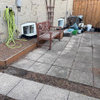Soil improvement for clay?
mad_gardener
15 years ago
Related Stories

GARDENING GUIDESGardening Solutions for Heavy Clay Soils
What’s a gardener to do with soil that’s easily compacted and has poor drainage? Find out here
Full Story
GARDENING GUIDESHow to Stop Worrying and Start Loving Clay Soil
Clay has many more benefits than you might imagine
Full Story
GARDENING GUIDESThe Poop Scoop: Enrich Your Soil With Good Old Manure
Get over the ick factor already — this natural super-ingredient for soil has so many benefits, you'll wonder why you ever went chemical
Full Story
GARDENING GUIDES10 Solutions for Soggy Soil
If a too-wet garden is raining on your parade, try these water-loving plants and other ideas for handling all of that H2O
Full Story
GARDENING GUIDESGet the Dirt on Your Garden’s Soil
Understand how your soil supports your plants so you can ensure your garden’s success
Full Story
LANDSCAPE DESIGNHow to Shape a Rain Garden and Create the Right Soil for It
Learn how to grade, lay out and amend the soil in your rain garden to support your plants
Full Story
FARM YOUR YARDHow to Get Good Soil for Your Edible Garden
The nutrients in your soil feed the plants that feed you. Here are tips on getting it right — just in time for planting season
Full Story
CONTAINER GARDENSContainer Gardening Basics: The Dirt on Soil
Learn the types of potting soil available and the best mixes to help your containers thrive
Full Story
GARDENING GUIDESHave Acidic Soil in Your Yard? Learn to Love Gardening Anyway
Look to acid-loving plants, like conifers and rhododendrons, to help your low-pH garden thrive
Full Story
GARDENING GUIDES5 Prairie Wildflowers That Can Heal Your Soil
Get free, organic soil fertilizer with nitrogen-pumping plants that draw pollinators too
Full StoryMore Discussions








orgarden
Kimmsr
Related Professionals
Carlisle Landscape Architects & Landscape Designers · Ashland Landscape Architects & Landscape Designers · Foothill Ranch Landscape Architects & Landscape Designers · Burien Landscape Contractors · Dedham Landscape Contractors · Dinuba Landscape Contractors · Galt Landscape Contractors · Round Lake Landscape Contractors · Setauket-East Setauket Landscape Contractors · Tigard Landscape Contractors · Baltimore Decks, Patios & Outdoor Enclosures · Bonita Decks, Patios & Outdoor Enclosures · Brookfield Decks, Patios & Outdoor Enclosures · Lebanon Decks, Patios & Outdoor Enclosures · Chesapeake Ranch Estates Stone, Pavers & Concretebillhill
gardengal48 (PNW Z8/9)
organicguy
dchall_san_antonio
mad_gardenerOriginal Author
organicguy
justaguy2
lou_spicewood_tx
justaguy2
Kimmsr
dchall_san_antonio
rhizo_1 (North AL) zone 7
ggrigs
organicguy
dicot
Kimmsr
organicguy
Kimmsr
organicguy